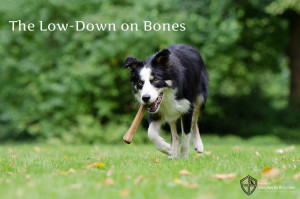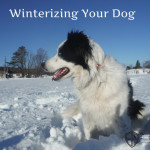The Low-Down on Bones
The Low-Down on Bones

Is there anything more idyllically matched than dogs and bones? Despite the age-old belief that dogs should be given these calcium-rich by-products, there is a lot of modern empirical evidence that says bones may not be the best choice for your pup. While it is a choice you need to make for your dog, there are a few considerations you should think about before making your final decision.
As we head into the holiday season, there are many occasions when your dog may find himself in an opportune position to swipe a bone or two – a holiday dinner plate left unattended, the turkey carcass sitting in the trash… you get the idea. Perhaps you have even slipped him a tasty thigh bone here or there as a treat. So why is it this a practice that should be curtailed?
BAD TO THE BONE
Bones aren’t in and of themselves “bad”. They can be a great source of nutrients for your dog, if rendered into bone meal. The real trouble comes when dogs get a hold of whole bones, regardless of whether they’re poultry, beef, pork, venison, etc. Cooked or raw, they can pose several different dangers to your dog’s well-being.
COOKED BONES
Cooked bones are an absolute no-no. Cooking changes their composition, making them ticking time bombs. Most people already know that it’s unwise to feed your dog cooked bones – especially chicken bones. However, the “why’s” may not be as clear. Here are a few reasons cooked bones can be so dangerous:
- Cooked bones have a tendency to splinter. These sharp pieces of bone can not only become lodged in the mouth, throat and digestive tract, but they can also cause punctures or tears in the tissues of these sensitive areas.
- If a bone fragment punctures through the digestive tract, it can lead to several serious problems, including perforation of the stomach or colon, and very likely subsequent peritonitis (a widespread infection of the abdominal cavity due to the introduction of foreign matter). This is probably the most dangerous possibility, necessitating surgery and heavy-duty antibiotic therapy. The outcome is often highly dependent on how advanced the perforation and/or infection is.
- Shards of bone can collect in the stomach or intestines, creating a hard impaction that will very likely require surgery.
- Bone splinters can get caught in the mouth and gums. It’s not all that uncommon for a dog to present with a dental abscess, only to find that a bone splinter has lodged alongside the tooth, creating the perfect environment for infection.
RAW BONES
Raw bones can present their own set of complications. While it’s less likely to have a raw bone break and splinter, they can still cause problems for you and your dog. Some diets recommend feeding raw chicken with the bones still intact, or beef-origin bones. While the idea behind it is solid, it’s not always worth the risks they can pose to your dog’s safety and well-being. It completely depends on the dog, his eating habits, and your own experience and beliefs about what and how to feed your pup.
- Raw bones are semi-flexible. This means they are more easily swallowed whole, especially by “gulpers.” However, large, unyielding objects in the digestive tract can cause blockages.
- Just like cooked bones, raw bones can occasionally splinter, cause perforations or gather in the intestines and create dangerous impactions.
- Due to their “rubbery” nature, raw bones can lodge between teeth on the upper or lower arcades, requiring a visit to the vet to have it removed.
- Raw bones can carry high levels of bacteria, making infection with digestive ailments, such as E. coli, a greater possibility. The risks go up as the bones may sit and further spoil if not consumed right away.
Ultimately, whether or not you decide to give your dog raw bones is a decision you need to make, based on your own research and consultation with your vet. Under no circumstances should a dog ever receive cooked animal bones – the risks for injury so greatly outweigh any possible benefits.
Article By:
Jennie Eilerts






